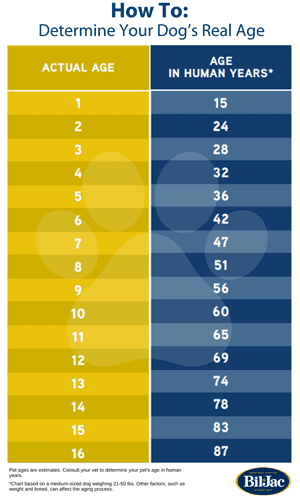Have you ever wondered why we talk about “dog years” or how old your furry friend really is in human terms? The concept of dog years has been around for decades, but it’s often misunderstood. In this post, learn how dog years work, how to calculate your pet’s age accurately, and why understanding dog years matters.
The Origins of the Seven Year Rule
At some point, you may have heard that one dog year equals seven human years. This rule of thumb became popular because it’s easy to remember and, for a while, seemed like a convenient way to think about your dog’s age. The problem is that it’s not accurate.
The seven-year rule is an oversimplification that has been shared for decades, but it’s not the first time that people have used faulty math to determine their dog’s “human” age. Priceonomics reports that one calculation dating back to 1268 suggested that every human year equaled nine dog years.
The seven-year rule gained popularity in the 1950s in part because it’s easy to calculate, but that simple ratio doesn’t account for the nuances of how dogs age. As a result, there are a few common misconceptions that you may have heard.
- All dogs age at the same rate.
- A 10-year-old dog is equivalent to a 70-year-old human.
- Small dogs and large dogs age similarly.
How Dog Years Actually Work
The reality is that dogs age more rapidly in their early years. Your furry four-legged friend’s aging process slows down dramatically after their first year before leveling off around their third year of life.
Of course, even that description doesn’t quite capture the intricacies of how dogs age. Each dog is different, and some will mature more quickly than others. Several factors influence how a dog ages.
- Size and breed: Smaller dogs tend to live longer than larger breeds, which can impact how they age. For example, a Chihuahua may not reach “senior” status until they are 10-12 years old, whereas a larger breed like a Great Dane might be considered a senior by the age of 6-7 years. This difference in aging can lead to variations in how quickly they mature and how their health needs change over time.
- Genetics: Some breeds are predisposed to longer lifespans despite their size. For instance, despite being a medium-sized dog, a Border Collie often lives into their mid-teens, thanks to their genetics. On the other hand, a breed like the Bulldog, known for its shorter lifespan due to genetic predispositions, might start showing signs of aging much earlier, around 5-6 years of age, even though they are not considered a large breed.
How to Calculate Dog Years
Today, veterinarians and researchers use more sophisticated methods to estimate a dog’s age in human years. However, the average pet parent isn’t a math major or a data scientist.
The good news is that you can still get pretty close. While it may not give you an exact estimate of your dog’s human age, the American Veterinary Medical Association (AVMA) provides some guidelines on how to calculate your dog’s age.
- Fifteen human years equals the first year of a medium-sized dog’s life.
- Year number two for a dog equals about nine years for a human.
- And after that, each human year would be approximately five years for a dog.

Why Understanding Dog Years Matters
So why should you care about dog years? Understanding dog years isn’t about satisfying curiosity – it’s important for your dog’s health and well-being.
Knowing your dog’s age in human terms can help you better understand their needs during each stage of their life.
- Puppyhood: In the first year, your dog is rapidly developing, both physically and mentally. This is the time for training, socialization, and setting the foundation for a well-behaved adult dog.
- Adulthood: As your dog transitions into adulthood, their energy levels and nutritional needs change. Understanding their “human age” can help you better understand how to adjust their diet and exercise routine accordingly.
- Senior years: When your dog enters their senior years, they may start to slow down and could be more prone to health issues. Recognizing this phase early on allows you to provide the extra care and veterinary attention they may need.
How to Keep Your Dog Happy and Healthy No Matter Their Age
By understanding how your dog ages, you can ensure that they get the appropriate care, exercise, and nutrition they need at every stage of their life, helping them to live a long, healthy, and happy life by your side.
Want to learn more about how you can help your furry friend stay happy, healthy, and well fed? Sign up for the Best Friends Club for more educational articles, special tips, and members-only discounts on Bil-Jac treats and other products.





